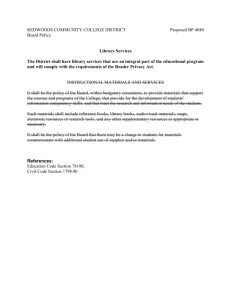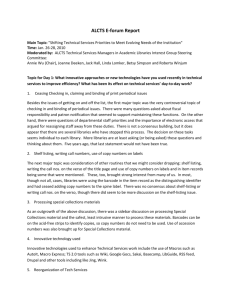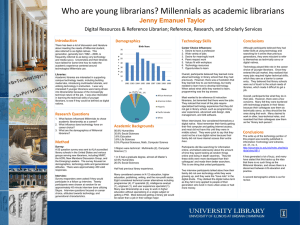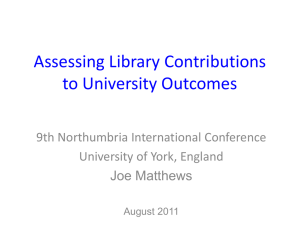Statement of Competency F
advertisement
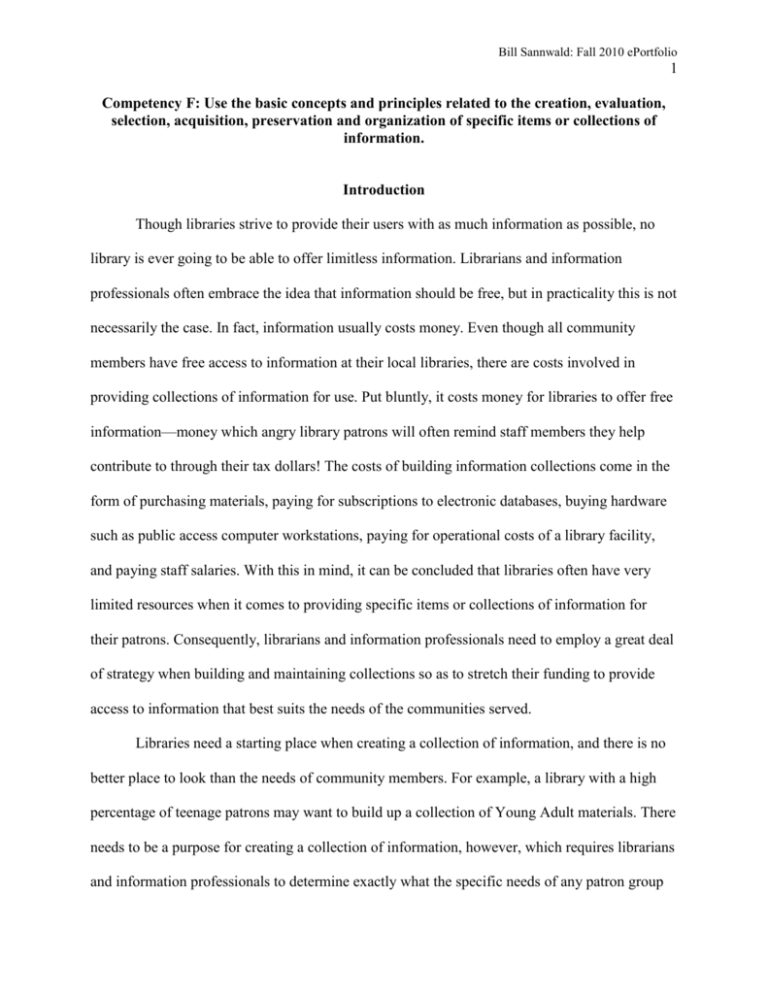
Bill Sannwald: Fall 2010 ePortfolio 1 Competency F: Use the basic concepts and principles related to the creation, evaluation, selection, acquisition, preservation and organization of specific items or collections of information. Introduction Though libraries strive to provide their users with as much information as possible, no library is ever going to be able to offer limitless information. Librarians and information professionals often embrace the idea that information should be free, but in practicality this is not necessarily the case. In fact, information usually costs money. Even though all community members have free access to information at their local libraries, there are costs involved in providing collections of information for use. Put bluntly, it costs money for libraries to offer free information—money which angry library patrons will often remind staff members they help contribute to through their tax dollars! The costs of building information collections come in the form of purchasing materials, paying for subscriptions to electronic databases, buying hardware such as public access computer workstations, paying for operational costs of a library facility, and paying staff salaries. With this in mind, it can be concluded that libraries often have very limited resources when it comes to providing specific items or collections of information for their patrons. Consequently, librarians and information professionals need to employ a great deal of strategy when building and maintaining collections so as to stretch their funding to provide access to information that best suits the needs of the communities served. Libraries need a starting place when creating a collection of information, and there is no better place to look than the needs of community members. For example, a library with a high percentage of teenage patrons may want to build up a collection of Young Adult materials. There needs to be a purpose for creating a collection of information, however, which requires librarians and information professionals to determine exactly what the specific needs of any patron group Bill Sannwald: Fall 2010 ePortfolio 2 are. Teenage patrons at a particular library, for example, may be far more in need of college preparatory materials than Young Adult fiction. Identifying the areas of need is the first step of the creation process in building a collection of information, and much work has to be done beyond this initial step in order to gather resources that are relevant to the needs of users. The next step in building a collection of information is to evaluate the specific needs of the target users. Simply purchasing Young Adult materials, for instance, is not enough. A previously stated, there needs to be a purpose for the creation of a collection of information, and materials should be purchased in line with this purpose. Librarians and information professionals need to evaluate the specific needs of a group the collection of information is being created for so as to better understand the types of subjects, formats, and amounts that are most suitable. Perhaps one library’s collection for a target demographic may be mainly fiction materials, while at another library it may be mostly non-fiction materials. Sometimes a collection of information may only need to be a few items, whereas other times it may occupy an entire section in a library. Users at one library may only need materials in print format, while users at another library may have more of a demand for electronic access to information. In short, needs differ from library to library. Selecting materials for a collection of information requires utilizing tools that provide professional and practical guidance. Even though it’s a nice idea that librarians and information professionals would have the time to personally review all potential resources to add to collection of information, this scenario is far from reality. Thankfully, there are many selection tools that can assist in choosing materials to add to a collection of information. Some key examples of selection tools include professional reviews such those found in trade publications, professionally-compiled booklists such as those published by the American Library Association, Bill Sannwald: Fall 2010 ePortfolio 3 recommendations from peer librarians, discussions on professional discussion boards or e-mail listservs, and input from representatives of the target audience. Once materials have been selected, the next step is to acquire them. Returning to the idea that most libraries operate under limited funding, great care needs to be made in making budgets stretch as far as possible so as to acquire the largest amount of information at the lowest potential cost. Many times libraries have contracts that only allow them to purchase materials and subscriptions through specific vendors, which may limit a library’s ability to acquire certain necessary items. However, sometimes outside supporters like Friends of the Library groups can assist in acquiring materials to help build a collection of information. Thus, creativity can sometimes be required for acquiring materials. Preserving a collection of information is also important when thought of in terms of libraries operating under limited budgets. The longer a library can go without having to replace an item, the less impact there will be on a library’s budget. Preservation goes far beyond physical preservation techniques such as putting projective covers on books. In essence, preservation of an information collection means ensuring the information remains available for use in a way that is as widely accessible as possible for as long as possible. Librarians and information professionals need to balance the preservation of materials with the ways in which preservation strategies will limit users’ ability to access the information. For example, sometimes libraries keep costlier items in their Reference sections, meaning those materials can only be used at the library. This limits the access some patrons may have to the information. At the same time, electronic collections of information may not be accessible to patrons lacking the proper computer skills or hardware resources. Therefore, when thinking about the long-term Bill Sannwald: Fall 2010 ePortfolio 4 preservation of materials, the format types and methods of access should be strongly considered in relation to the needs of the target demographic. Finally, specific items or collections of information need to be organized in a logical, consistent, and easy-to-access manner in order to allow the users in need of the information to actually find it and utilize it. Organization is a multifaceted challenge for librarians and information professionals. Many public libraries utilize a standardized classification system like the Dewey Decimal System to organize their physical collections of information, though librarians and information professionals should keep in mind that sometimes these types of classification systems can be confusing for some patrons. In other words, there will always be users that need guidance from professionals to find the information they seek. The physical layout of a library is a significant part of organization in that the placement and visibility of a collection of information will affect its usage. One example that I have encountered in my professional career is with non-fiction materials. Some libraries interfile juvenile non-fiction materials with the general collection, while other libraries keep the juvenile and adult non-fiction materials in separate areas. Children may not browse the adult non-fiction section (or vice-versa) to find the materials they seek, yet dividing materials by reading level means users wanting to locate information on a particular subject have to potentially search two separate areas. Beyond the physical organization of collections of information, librarians and information professionals need to consider the electronic organization of materials as well. The way items are cataloged in a library’s database can affect users’ ability to locate relevant resources when searching for information in a library’s information retrieval system. Presenting information in an electronic format that is easily searchable is challenging because no two users look for information in exactly the same way, not to mention all users have varying degrees of Bill Sannwald: Fall 2010 ePortfolio 5 skill utilizing electronic resources. Electronic access to collections of information holds the largest potential for quick and widespread information dissemination, but librarians and information professionals should realize that electronic formats may not always be most suitable for the target demographic of the information collection. Once specific items have been acquired to build a collection of information, librarians and information professionals should engage in regular reevaluation of the resources. It is important to remember that no community of users is stagnant, and the needs of users are sure to change over time. Collections of information may need to be bolstered by acquiring additional resources, and specific items may need to be deselected from the collection as well. For instance, a collection of medical books should be reevaluated on an ongoing basis so as to make sure there is no outdated information that may prove to be incorrect or even dangerous. Also, the format needs of users should be reconsidered on a regular basis as well. Sometimes the preferred formats to access information will change, and librarians and information professionals should shift the collection consequently. Collection evaluation is a continual process that ensures libraries are supplying users with the most relevant and appropriate information in the most efficient and accessible manner as possible. Competency Development Throughout my career working in libraries, I have had the opportunity to engage in creating and maintaining collections of information. My first experience came in the form of checking the circulation statistics and condition of items for deselection purposes. Deselecting materials, often referred to as “weeding,” generally involves removing items from a library’s collection on the basis of their frequency of use, relevancy to current information needs, Bill Sannwald: Fall 2010 ePortfolio 6 accuracy of content, and physical condition. Over the course of my professional development I began having more of an active role in the creation of specific collections of information. For example, while still working as a paraprofessional, I built a graphic novel collection for the Mission Valley Branch Library. This involved evaluating which materials would be most appropriate for the target user group, consulting selection tools to make optimal choices of titles to order, submitting an order to our library’s vendor, preserving the longevity of the collection by adding book covers and other protective materials, and finding a suitable physical location within the library to house the materials. Now that I am a Youth Services Librarian, maintaining my library’s collections of information for children and Young Adults is one of my main job duties, and given the current economic climate libraries are operating it, it has proven very challenging. Trying to make the most use of limited funds is a skill I am still developing, but I have been able to combine my professional experience with what I’ve learned in my MLIS studies to better hone my collection management skills. In Dr. Arglenda Friday’s “Collection Management” (LIBR 266) course, I created a fictional “Opening Day Collection” of Young Adult materials with a vampire theme. The goal of the assignment was to introduce students to the process of building a collection of information. The process of creating the information collection began with assessing the needs of the community serviced by the library by checking information such as Census data. Once that was complete, the creation process involved identifying the purpose of the collection, describing measurable objectives for meeting the purpose, gauging the collection’s intended scope and formats, evaluating user expectations, identifying and consulting a wide range of appropriate selection tools, selecting materials to purchase, allocating funds so as to allow the for the acquisition of the most amount of resources possible, and detailing evaluation techniques to Bill Sannwald: Fall 2010 ePortfolio 7 maintain the collection’s relevancy. Put simply, the “Opening Day Collection” is a strong piece of evidence because it guided me through the entirety of the process of building a collection of information. In fact, I have adopted much of what I learned from completing the assignment for use in my professional career. My second piece of evidence is another document created while taking “Collection Management” (LIBR 266). My “Collection Evaluation Assignment” required me to examine a certain area of a library’s collection and consider factor such as the scope of the collection, the age and condition of materials, the target audience, and the actual usage the collection receives. Once the collection had been evaluated, I made recommendations on how to make improvements. I chose to evaluate the college preparatory materials at the Malcolm X Branch Library. My specific recommendations included increasing the visibility of the materials by housing them in their own section, increasing the depth of the collection, engaging in stronger promotion of the collection, and involving the community in the further development of the collection. Using the assignment as an opportunity to conduct an evaluation of a collection at my own library provided me with a better understanding of the importance regular evaluation can hold for collection maintenance and improvement. My third piece of evidence also comes from “Collection Management” (LIBR 266). Entitled “Collection Development Comparison Chart,” the document is a comparison of the collection development policies of San Diego Public Library and Pasadena Public Library. The project required me to examine such criteria as the target audiences serviced, the types of patron needs, the organization of the collections, the formats collected, the identification of persons responsible for collection development, the handling of gift materials, the deselection and discarding of materials, how patron complaints are handled in relation to censorship, how gift Bill Sannwald: Fall 2010 ePortfolio 8 materials are handled, the types of electronic resources offered, and the evaluation methods the libraries utilize. The methods through which collections of information are created are often dictated by collection development policies, but it is important to remember that collection development policies should be a reflection of the communities the libraries serve. My final piece of evidence is a critique of an article I wrote while enrolled in Dr. Ziming Liu’s “Information and Society” (LIBR 200) course. The document, “Literature in a Digital Age,” examines the challenges that digital preservation poses to long-term information access. With a growing amount of information becoming available in digital formats, the ease of accessibility these formats provide may be appealing to librarians. However, as is pointed out in the critique, the ability to access electronic information may lack longevity. For example, recently I upgraded the operating system on my home computer, but now it lacks the ability to read many of the CD-ROMs I own because they were created to run on previous operating systems. Access to electronic information requires the use of tools like computers and decoders like software programs. Librarians and information professionals should take serious consideration of the advantages and disadvantages of all formats when making selections for a collection of information. Evidences F1. Opening Day Collection o Details the entire process of creating a collection of vampire-themed Young Adult materials including evaluation, selection, acquisition, and organization. F2. Collection Evaluation Assignment Bill Sannwald: Fall 2010 ePortfolio 9 o Critiques a library’s collection of college preparatory materials on factors such as the collection’s scope and condition. F3. Collection Development Comparison Chart o Compares the collection development policies of San Diego Public Library and Pasadena Public Library. F4. Literature in a Digital Age o Examines the advantage and disadvantages of preserving information digitally. Concluding Remarks Because libraries usually operate with limited resources, it can be a challenge to even build a collection of information in the first place. Librarians and information professionals need to make smart decisions in how best to offer information to library users. When building a collection of information, there must first be a purpose and target audience identified. Libraries should provide communities with the most relevant information possible, even with budget restrictions. Evaluating community needs, consulting selection tools to make informed decisions, considering format types, acquiring materials in a cost effective manner, implementing preservation methods to ensure longevity of the materials, organizing the materials in a logical and accessible manner, and continually reevaluating the effectiveness of the collection are all critical components of the collection development process. The types of information needed by members of any community are sure to change over time, meaning librarians and information professionals should never their collections of information remain stagnant. Information collections need to be regularly updated through both the addition of new resources as well as the deselection of materials that are out of date, low circulating, or in poor physical condition. Bill Sannwald: Fall 2010 ePortfolio 10 Creating collections of information is not easy by any means, but it is a process all librarians and information professionals need to master in order to meet community informational needs. Following an effective collection development process will go a long way to ensure that librarians and information professionals have the tools to create relevant collections of information, even if the funding at their disposal is much lower than desired.
